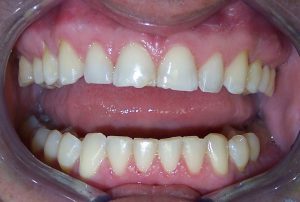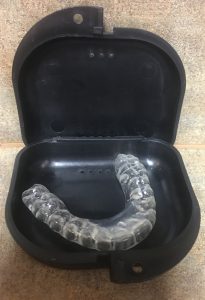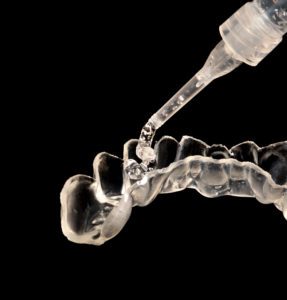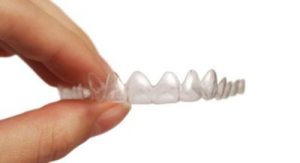Aging Smiles: What Makes a Smile Look “Old”?
Did you know that your smile can make you look younger or older than you really are? The shape, color, and position of the teeth and gums all have an impact on the “age” of your smile. This week’s blog describes the effects that aging can have on your smile.
Attrition
 Attrition is the scientific term we use to describe a slow, gradual shortening of the teeth. The biting edges of the front teeth become flatter as they wear down from decades of use. There are a few things that can accelerate this process and make teeth look older than they really are.
Attrition is the scientific term we use to describe a slow, gradual shortening of the teeth. The biting edges of the front teeth become flatter as they wear down from decades of use. There are a few things that can accelerate this process and make teeth look older than they really are.
Teeth clenching or grinding
People who clench or grind their teeth at night cause the enamel more damage than what it would experience through natural wear. The heavy forces between the upper and lower teeth produced by clenched jaws is higher than the enamel was made to withstand, and therefore, it sustains more damage.
Sleep apnea or sleep-disordered breathing problems
Patients with constricted airways or obstructive sleep apnea (OSA) tend to push their lower jaws forward in an attempt to enlarge the airway and get more oxygen. This is a subconscious reflex that occurs during sleep as a response to the brain’s signal that it does not have enough oxygen. As the lower jaw presses forward, the lower from teeth grind against the backside and bottom edge of the upper front teeth, causing flattening and loss of enamel over time.
Porcelain dental work on the front teeth
Porcelain is harder than tooth enamel. If the two structures grind against each other, enamel loses. In cases of porcelain dental work, like crowns or veneers, the natural tooth that bites against it will suffer enamel damage and loss. Often we see six to eight upper porcelain veneers against natural teeth on the lower, and the lower teeth show significant attrition.
What Can I Do About Attrition?
 The very best tactic is to prevent it! You can prevent the flattening and shortening of teeth by wearing a protective nightguard while you sleep. This not only keeps your front teeth looking young and beautiful; it also protects your back teeth from cracking and breaking.
The very best tactic is to prevent it! You can prevent the flattening and shortening of teeth by wearing a protective nightguard while you sleep. This not only keeps your front teeth looking young and beautiful; it also protects your back teeth from cracking and breaking.
If you have already experienced significant flattening or shortening of your teeth and do not like its appearance, talk to Dr. Ann and Dr. Lauren about your options to restore these teeth. There are several different options to restore worn, old-looking teeth to their former appearance.
Gum Recession
You know that phrase “getting a little long in the tooth”? That phrase specifically describes someone’s aging, and it comes from the philosophy that everyone will eventually have receding gums. Gum recession makes teeth look longer and yellower. It also opens up small gaps between the teeth called black triangles. Gum recession does not have to be a normal part of the aging process. It results from a few preventable problems.
Gum disease
Gum disease, also known as periodontal disease, occurs when irritants like plaque and tartar buildup cause inflammation and infection in the gums and surrounding bone. The body’s natural response to these irritants is to get away from them. This causes bone loss and gum recession.
Teeth clenching or grinding
As stated earlier, clenching or grinding your teeth puts too much force o the teeth due to excessive pressure between the upper and lower jaws. This force causes damage to the gum tissue surrounding a tooth and can lead to recession.
In some cases, heavy clenching or grinding pushes the upper teeth outward (toward the lips and cheeks), and this also causes gum recession.
What Can I Do About Gum Recession?
Just like attrition, it is much simpler and less expensive to prevent gum recession. You an prevent gum recession by fighting the risk factors listed above: gum disease and teeth clenching or grinding. To fight gum disease, you must perform great oral hygiene at home (and yes, that means flossing every single day), as well as having professional teeth cleanings by a registered dental hygienist.
Your hygienist will help you discover and counteract your specific risk factors for gum disease. Patients who smoke or have diabetes have a much higher risk for gum disease and therefore, gum recession.
Yellowing
Most people want whiter teeth in order to prove the cosmetic appeal of their smiles. However, did you know that yellow teeth actually make you look older? Yellowing is a natural process of aging and is one of the most characteristic aspects of an aging smile. Over time ,yellowing occurs as a result of two factors. One is preventable, and the other is not.
Accumulation of stain from dark beverages, foods, and tobacco
Years and years of coffee drinking will cause a yellowing and darkening effect on the teeth. So will tobacco, tea, red wine and many other foods and drinks. There are several factors that impact how much stain your teeth will collect over time, including the surface texture of enamel, presence of dental work, oral hygiene, and consistent dental care (or lack thereof).
Obviously, this cause of yellowing is preventable. If you never eat, drink, smoke, dip, or chew anything dark, you will experience less yellowing of your teeth over your lifetime.
Changes in the tooth’s structure
Most people know that enamel is the outer, hard coating of every tooth. Enamel is general white in color, is slightly translucent and is a few millimeters thick on the outside of every tooth. Directly underneath the enamel is a structure called dentin. Dentin is a darker yellow color and is thicker than enamel. As we age, the dentin under our enamel gets thicker and thicker. This thicker layer of yellow underneath enamel causes an overall yellowing of the teeth. This problem is compounded by the fact that enamel may get thinner and more translucent over time, allowing more of the yellow dentin to show through.
What Can I Do About Yellowing?
 There are several ways to fight yellowing. The first, and most important, is to polish away surface stains with great home care and consistent teeth cleanings with Phyllis and Nancy. You can use a whitening toothpaste with an electric toothbrush to remove surface discoloration on a daily basis. (Talk to Dr. Ann or Dr. Lauren before proceeding with this if your teeth are sensitive or you have receding gums.)
There are several ways to fight yellowing. The first, and most important, is to polish away surface stains with great home care and consistent teeth cleanings with Phyllis and Nancy. You can use a whitening toothpaste with an electric toothbrush to remove surface discoloration on a daily basis. (Talk to Dr. Ann or Dr. Lauren before proceeding with this if your teeth are sensitive or you have receding gums.)
The next option is to whiten your teeth with professional teeth whitening. The peroxide compounds in professional teeth whitening products penetrates underneath enamel to break down dark molecules in the underlying dentin. This is a very simple process, and almost anyone can whiten their teeth.
Some may keep consistent dental visits with their hygienist, have great home care, and use professional teeth whitening products, to no avail. If you are still unhappy with the yellowed color of your teeth, it may be time to consider cosmetic dentistry options like veneers. Come see Dr. Ann and Dr. Lauren for a cosmetic consultation to discuss your options!
Crowding
Particularly on the lower front teeth, crowded and crooked teeth are a common indication of an aging smile. Another natural part of the aging process on our teeth is a forward motion toward the front of the mouth. This leads to the small front teeth (incisors) all piled upon each other in severe crowding. This is not simply a cosmetic issue, either. It leads to difficulty cleaning this area, which can in turn lead to gum disease and cavities.
What Can I Do About Crowding?
 Again, it is much easier and inexpensive to prevent teeth crowding. You can do this by wearing a retainer while you sleep. Even if your teeth are not perfectly straight, wearing a retainer will keep them where they are and stop them from getting more crowded over time.
Again, it is much easier and inexpensive to prevent teeth crowding. You can do this by wearing a retainer while you sleep. Even if your teeth are not perfectly straight, wearing a retainer will keep them where they are and stop them from getting more crowded over time.
If your teeth have already begun crowding, and you would like to straighten them, talk to Dr. Ann and Dr. Lauren about straightening your teeth with Invisalign. Straight teeth look younger than crooked teeth, and you can whiten as you straighten.
Do You Have Specific Questions about Your Smile and How it is Aging?
Call Designer Smiles today to schedule a consultation with Dr. Ann and Dr. Lauren. They can help you evaluate your smile to determine which options will counteract the effects of aging and give you a natural, beautiful smile.
